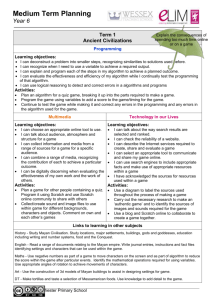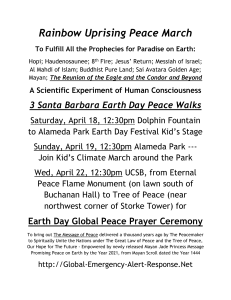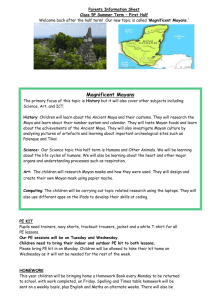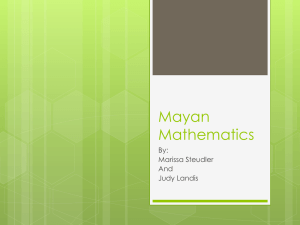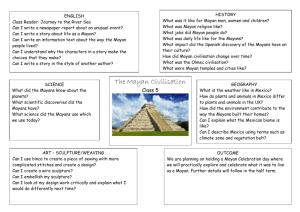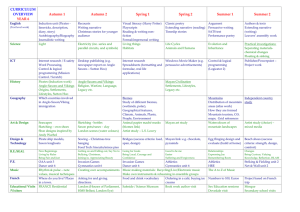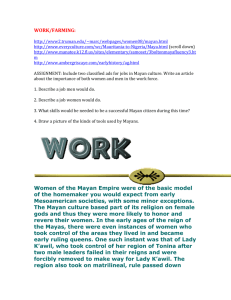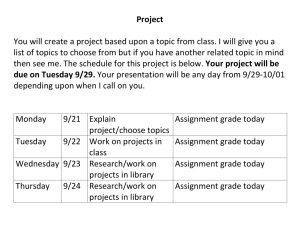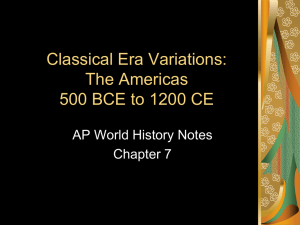Hirsch-Dubin
advertisement
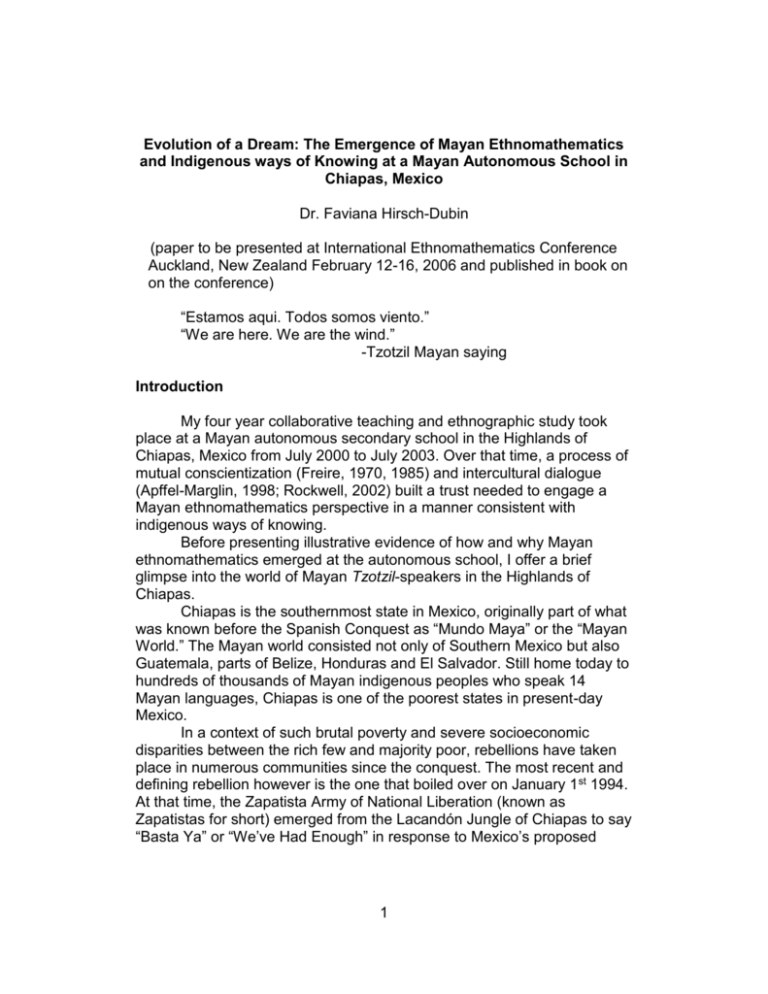
Evolution of a Dream: The Emergence of Mayan Ethnomathematics and Indigenous ways of Knowing at a Mayan Autonomous School in Chiapas, Mexico Dr. Faviana Hirsch-Dubin (paper to be presented at International Ethnomathematics Conference Auckland, New Zealand February 12-16, 2006 and published in book on on the conference) “Estamos aqui. Todos somos viento.” “We are here. We are the wind.” -Tzotzil Mayan saying Introduction My four year collaborative teaching and ethnographic study took place at a Mayan autonomous secondary school in the Highlands of Chiapas, Mexico from July 2000 to July 2003. Over that time, a process of mutual conscientization (Freire, 1970, 1985) and intercultural dialogue (Apffel-Marglin, 1998; Rockwell, 2002) built a trust needed to engage a Mayan ethnomathematics perspective in a manner consistent with indigenous ways of knowing. Before presenting illustrative evidence of how and why Mayan ethnomathematics emerged at the autonomous school, I offer a brief glimpse into the world of Mayan Tzotzil-speakers in the Highlands of Chiapas. Chiapas is the southernmost state in Mexico, originally part of what was known before the Spanish Conquest as “Mundo Maya” or the “Mayan World.” The Mayan world consisted not only of Southern Mexico but also Guatemala, parts of Belize, Honduras and El Salvador. Still home today to hundreds of thousands of Mayan indigenous peoples who speak 14 Mayan languages, Chiapas is one of the poorest states in present-day Mexico. In a context of such brutal poverty and severe socioeconomic disparities between the rich few and majority poor, rebellions have taken place in numerous communities since the conquest. The most recent and defining rebellion however is the one that boiled over on January 1 st 1994. At that time, the Zapatista Army of National Liberation (known as Zapatistas for short) emerged from the Lacandón Jungle of Chiapas to say “Basta Ya” or “We’ve Had Enough” in response to Mexico’s proposed 1 entry into NAFTA (North American Free Trade Agreement) with the United States and Canada. NAFTA was seen as significantly worsening an already catastrophic set of conditions of both urban and rural poverty in Mexico. Key to understanding a broader context of the autonomous secondary school in which my project and research took place, is realizing that the Zapatista rebellion unleashed a transformative process throughout Chiapas. A movement for autonomy, a self-initiated and self-defined community based democratic process, was at the heart of education, health care and many aspects of civilian life. Autonomous education meant that Mayan youth would no longer have to be educated exclusively in government schools, where they would be punished for speaking their Mayan languages and be taught a history that denied Mayan civilization ever existed. Thus, the Mayan community’s autonomous secondary school in the Highlands of Chiapas (Los Altos) represents a remarkable achievement. The head of the community’s elected education committee at the school often tells visitors that it took a collective dream to produce the autonomous school. Dreams occupy an important place for Mayan peoples who envision and enact change amidst such severe conditions of daily life. The dreams harken back to a rich, advanced civilization before the conquest of Mayan lands and beckon the future, birthing what is possible for Mayan peoples to achieve today. Within this unique set of historical, social and political circumstances, a collaborative teaching project was initiated at the autonomous school. It was a collaboration that centered on Mayan ethnomathematics as ancient practices, contemporary approaches to solving problems, and artistic expressions that are part of daily life in the communities. Why an important resource? Within the stated goals of the autonomous Mayan school to “revitalize language, culture and resources”, Mayan ethnomathematics could be seen as a vital cultural resource. Yet is was not understood in this way by everyone in the school community and was not accessible as a resource. It was not accessible as a resource due to the colonial policies of Spain followed by those of the Mexican government, which sought to destroy and devalue the extraordinary achievements of Mayan civilization. It thus became my task to bring textual, analytical and concrete resources 2 to the school site to materially support an argument for Mayan ethnomathematics. A telling quote from “Adrian”, the head of the Education Committee, attests to the destruction of ancient Mayan resources. “ Every people has its roots and must defend them. The Mayans observed the stars without great lenses and could tell all the planetary cycles. That education of ours was destroyed.” (My simultaneous translation of Adrian speech, 3-26-02) Ethnomathematics does not just represent an interesting “angle” on mathematics but a way of knowing the world and acting upon it. As a collaborative teacher and ethnographer at the site, it became clear that ancient Mayan mathematics and current practices in the community could be extremely valuable, powerful resources that the school could take up if they chose that path. It is important to indicate that a methodology had to be developed that was sensitive to indigenous knowledge and process of coming to know. This involved both a re-theorizing of an ethnographic participatory process on site and a willingness to follow the direction of indigenous scholars around the world who have raised powerful issues regarding research in indigenous contexts (Apffel-Marglin, 1998, 2004; Battiste, 2002; Grillo, 1998; Kawagly and Barnhardt, 2005; McKay, 1999; Smith, 1999). While there is not space here to explore this perspective further, it is crucial to note that the work of indigenous scholars, like that of Maori professor Linda Tuhuwai Smith of New Zealand, provides insights into “decolonizing methodologies” (Smith, 1999) and the need to transform the role of researchers. These questions are valid in my opinion and call for an awareness that may well reflect perspectives already guiding ethnomathematics projects in indigenous communities around the world. Thus, the role of ethnomathematics in “marginalized cultures” is integral to reclaiming knowledges forcibly removed by colonialism and a reaffirmation of cultural approaches to mathematics. Developing locally based approaches that challenge the hold of European dominated mathematics (Bishop, 1988; D’Ambrosio, 1985; Gerdes, 1985; Powell & Frankenstein, 1997) has constituted an important direction within the international ethnomathematics movement for a number of years. 3 The Case of Mayan Ethnomathematics in Chiapas The methodological approach in my work at the autonomous school in Chiapas utilized participant observation and fieldwork, accomplished both within formal ethnomathematics workshops with promoters (teachers) and students as well as outside that structure. I lived for month-long cycles at the school during the period from July 2000 to July 2003, which permitted a variety of interactions out of which primary data were derived. Although I had a broad spectrum of experiences living at the school, there was an agreement made between the school leadership and myself that my research product would be focused on our collaborative mathematics workshops. A guiding theme throughout this project was the school’s position that they did not want to be “objects of research,” which tailored all aspects of how this collaborative teaching/study was carried out. At each stage, results of where we had come thus far were communicated to the educational leadership and those with whom I worked, to permit greater collaboration. A context for examining specifics of the case in Chiapas was a view of mathematics that was formally expressed by several promoters at a school evaluation meeting in August 2001 which stated that “2X2=2X2 no matter what.” This was articulated in response to a question posed about what made subjects more or less autonomous and Mayan at the school. This more “universal” view of mathematics appeared to derive from a separation of mathematics from other areas of study at the school which were more integrated with Mayan history and perspectives, like social studies and the bilingual use of native Mayan languages. While all members of the school community did not hold this view of mathematics, as there were students who were anxious to investigate Mayan mathematical history and cultural approaches to mathematics, it did represent a stated position of the school at that time. What followed from August 2001 on was a progressive unfolding of Maya-centered mathematical consciousness and practice that had been initiated in July 2000. My first 10-day workshop with promoters (teachers) in July 2000 began a dialogic exploration of Mayan mathematics. At that time, we started to investigate accomplishments of ancient Mayan mathematics rooted in astronomical calculations and a precise counting of time through the use of two different calendars, solar and ritual. We also examined mathematics embedded in Mayan notions of cosmology, art and rituals, as well as the practice of ancient Mayan vegisimal numeration. These kinds of investigations into ancient mathematical systems propelled us into a previously inaccessible world. It prompted promoters to link the 4 ancient Mayan mathematical system and its current applications to their “ancestry as indigenous of Chiapas.” In July 2002 we had a one-day promoter workshop on Agriculture and Ethnomathematics that constituted another turning point in the collective emergence of Mayan ethnomathematics. My introduction to the workshop framed our dialogue in the context of why “2X2=2X2 did not mean there is no Mayan ethnomathematics.” I presented many examples, visually and verbally, of indigenous communities throughout the world, from Mozambique to the Amazon, reconnecting and revitalizing precolonial ethnomathematics knowledges and practices. Teams of promoters then came up with contrasts between agricultural practices used today and those used traditionally. The same teams investigated the mathematics embedded in each agricultural practice. This process surfaced important cultural aspects that had been lost over time, like traditional “use of prayers before planting” and “counting planting times using traditional months.” The view based on these changes was that traditional months of the Tzolkin or ritual calendar, no longer in use in Chiapas, removed a way to monitor periods of agricultural cycles as well as practice agriculturally- related religious ceremonies. Making visible these kinds of cultural losses provided convincing evidence to promoters that Mayan ways of practicing mathematics was not only relevant for the school but in danger of disappearing in the communities. The promoters own collectively produced findings provided powerful illustrations of an argument for a Mayan ethnomathematics perspective. Their emerging perspective was strengthened by having access to books and articles on ethnomathematics in Spanish that I provided to the school. In July 2003, we had three weeks of workshops, approximately six hours per week per group, with promoters and students. In this fourth year of work at the autonomous school, a stronger sense of agency and an articulated ethnomathematics language was evident. There are several illustrative examples. One team of promoters responded to a question the first day of the workshop on “What is ethnomathematics” by saying, “It is created in the environment of each people, each culture, like the example of Mayan mathematics which is its own knowledge.” Later that day, in the student workshop, a team of students responded to a question on “What is Mayan mathematics” by saying “ Mayan mathematics is the ideas of the Mayan world in which numbers were invented by necessity…this represents basic concepts of our culture.” Another team of students went on to say that, “It is difficult to reclaim Mayan mathematics because the 5 European invasion had other mathematics. Some elders have knowledge but not like before.” Working together in the student and promoter workshops, we explored many concrete manifestations of the power of ancient Mayan mathematics and its contemporary applications. One such example was the importance of zero, as a number, placeholder and philosophical concept of absence and completion. We also tried to comprehend the precise ancient Mayan astronomical calculations that produced a solar year, synodic revolutions of Venus and predicted eclipses, just to name a few. We explored the use of two calendars, one of which is still being used in he Mayan language Tzotzil in the Highlands of Chiapas today. Finally, our investigation into symmetrical patterns that are so much a part of embroidery and weaving indicated that distinctly Mayan approaches to mathematics are indeed part of everyday life. An additional perspective on shifts in understanding by promoters at the school was provided by the head of a consultant group, “Juana” who had been working with the school from its inception. “Juana” commented to me in a meeting off site in July 2003 that, “the promoters had gone through changes themselves, in their own rhythm and in their own time, over the past year (between 2002 and 2003) in seeing mathematics from a Mayan perspective.” This triangulated evidence helped to demonstrate that indeed a process of conscious change or conscientization (Freire 1970, 1985) accompanied by an indigenous approach to knowledge generation, supported the emergence of a Mayan ethnomathematics perspective at the autonomous school. Two written evaluations by promoters after the series of workshops in July 2003, further confirmed an emergence of a Mayan ethnomathematics perspective. One promoter wrote, “…we need to share with students so that they can have the same knowledge, so we can construct Mayan mathematics together.” Another promoter wrote, “For me it is necessary that the students know everything because they, like us, are descendants of the ancient Mayans. Therefore, it is our obligation and right to know what our ancestors did, and if possible, carry it on.” In conclusion, illustrative evidence indicates an emergence of Mayan ethnonmathematics over four years, supported by intercultural dialogue and a conscious process of change. This process included a willingness to problematize (Freire, 1970) what is known as “mathematics” and undertake a journey to see the potential relevance of and argument for a more Mayan centered view of mathematics. This is particularly important considering the impact of Spanish followed by Mexican colonialism in denying Mayan history and mathematics both in official 6 government education and in society as a whole. Thus, the autonomous Mayan school in Chiapas, Mexico had to “unfreeze” knowledge frozen by colonialism (Gerdes, 1988) to develop enough confidence as a community to claim Mayan ethnomathematics as a resource and perspective. Somos descendientes de los antiguos Mayas. Ellos tuvieron conocimientos extraordinarios y pudieron calcular muchas cosas en una manera muy avanzada. Queremos seguir sus pasos porque también nosotros somos Mayas. We are descendents of the ancient Maya. They had extraordinary knowledge and could calculate many things in an advanced way. We want to follow in their footsteps because we are also Mayas. -A student from the autonomous school 7 References Apffel-Marglin, F. (Ed.). (1998). The spirit of regeneration: Andean culture confronting Western notions of development. London: Zed Books. Apffel-Marglin, F. (2004). Criar juntos mundos vivos y vivicantes: Conversaciones entro lo andino y lo moderno. Balconcillo: Gráfica Bellido. Battiste, M. (2002). Indigenous knowledge and pedagogy in First Nations education: A literature review with recommendations. National Working Group on Education and Minister of Indian Affairs (INAC). Ottawa, ON. Retrieved from http://www.ainc.gc.ca/pub/krw/ikp_e.pdf Bishop, A. (1988). Mathematics education in its cultural context. Educational Studies in Mathematics, 19, 179-191. D’Ambrosio, U. (1985). Ethnomathematics and its place in history and pedagogy of mathematics. For the Learning of Mathematics, 5 (1), 44-48. Freire, P. (1970). Pedagogy of the oppressed. NY: Continuum. Freire, P. (1985). The politics of education. MA: Bergin & Garvey. Gerdes, P. (1985). Conditions and strategies for emancipatory mathematics education in underdeveloped countries. For the Learning of Mathematics, 5 (1), 15-34. Gerdes, P. (1988). On culture, geometrical thinking and mathematics education. Educational Studies in Mathematics, 19, 137-162. Grillo, E. (1998). Development or cultural affirmation in the Andes? In F. Apffel-Marglin with PRATEC (Eds.), The spirit of regeneration: Andean culture confronting Western notions of development (pp. 124-145). London: Zed Books. 8 Kawagly, A.O. & Barnhardt, R. (2005). Education indigenous to place: Western science meets native reality. Alaska Native Knowledge Network. Retrieved from http://www.ankn.uaf.edu/EIP.html McKay, M. (1999). Relating indigenous pedagogy to the writing process. Retrieved from http://www.sigc.edu/indian%20studiesindigenous thought/fall99/pedagogy-mckay.htm Powell, A.B. & Frankenstein, M. (Eds.). (1997). Ethnomathematics: Challenging eurocentrism in mathematics education. Albany, NY: SUNY. Rockwell, E. (2002). Constructing diversity and civility in the United States and Latin America: Implications for ethnographic educational research. In A.U. Bradley, N. Levinson, S.L. Cade, A. Padamer & A.P. Elvir (Eds.), Ethnography and education policy across the Americas (pp. 3-19). CT: Praeger. Smith, L.T. (2002). Decolonizing methodologies: Research and indigenous peoples. London: Zed Books. 9
